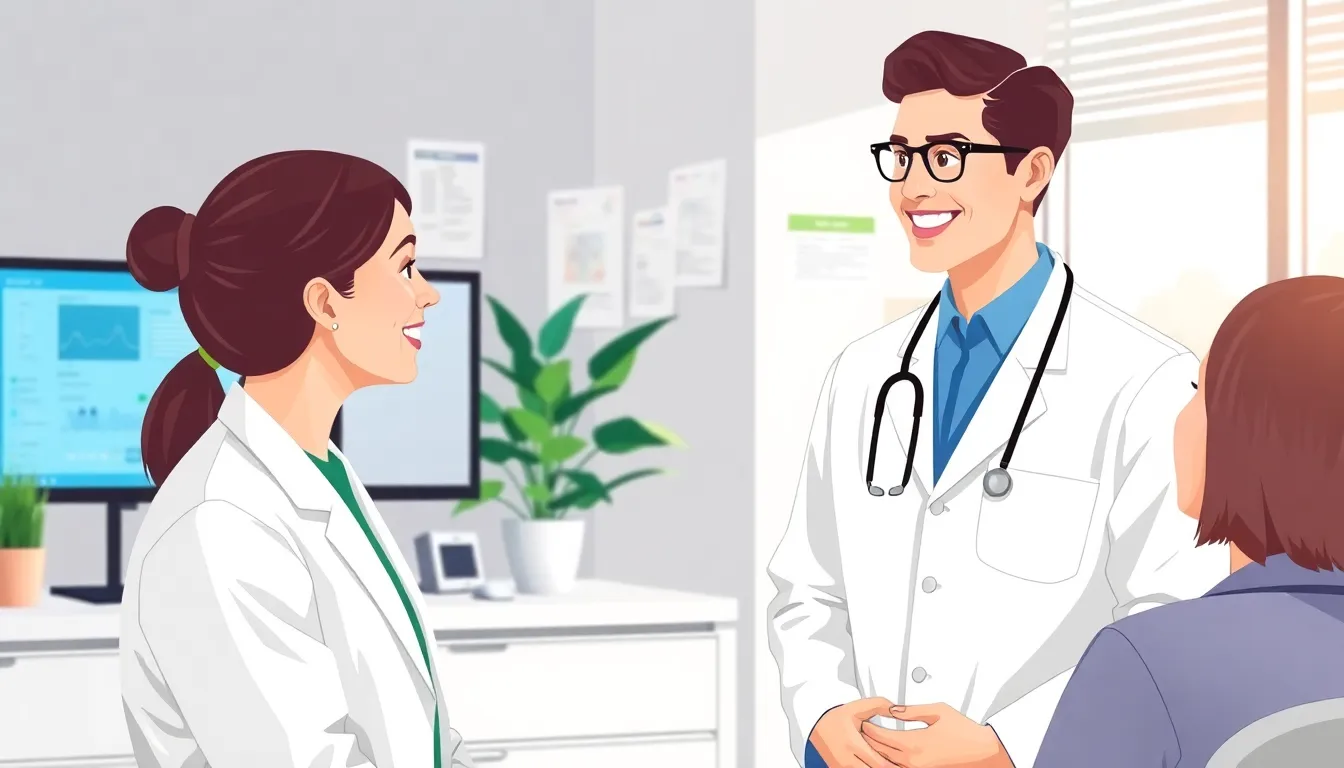Table of Contents
ToggleIn a world where even your coffee machine seems smarter than your doctor, medical software is stepping in to save the day. Gone are the days of cluttered paperwork and endless patient files. Today’s medical software is like that superhero we never knew we needed, swooping in to streamline processes and enhance patient care.
Overview of Medical Software
Medical software encompasses a range of applications designed to enhance healthcare delivery. Electronic Health Records (EHR) systems, practice management tools, and telemedicine platforms exemplify its diverse functionality. EHR systems allow for streamlined patient data management, ensuring easy access to vital information. Practice management tools improve appointment scheduling, billing processes, and patient communication, boosting overall operational efficiency.
Telemedicine solutions facilitate remote consultations, expanding access to care. These platforms bridge the gap between patients and healthcare providers, particularly in underserved areas. Other software types include laboratory information systems, which streamline lab operations and improve data accuracy. Patient engagement tools encourage individuals to take an active role in their health through reminders, education, and messaging systems.
Compliance with regulations such as HIPAA is crucial. Medical software must adhere to stringent guidelines to protect patient privacy and data security. Implementing safeguards minimizes risks associated with data breaches, ensuring patient trust. Integration capabilities further enhance the effectiveness of medical software. By connecting different systems within healthcare organizations, data sharing becomes seamless, leading to better coordination of care.
Training is vital for successful software implementation. Healthcare staff must understand how to use these tools effectively. Support from vendors aids in the transition, promoting a smoother workflow. Regular updates ensure software remains current with technological advances and regulatory changes.
Specific analytical tools provide insights into patient care patterns, enabling data-driven decision-making. Utilization of these insights helps healthcare providers identify areas for improvement, resulting in enhanced patient outcomes.
Types of Medical Software

Medical software serves various functions, enhancing healthcare delivery through technology. Different types exist, each designed to address specific challenges within medical practices.
Electronic Health Records (EHR)
Electronic Health Records (EHR) systems centralize patient data management. They provide healthcare professionals easy access to patient histories, diagnoses, medications, and treatment plans. Improved data accuracy becomes possible as EHRs reduce mistakes associated with paper records. Interoperability allows EHR systems to integrate with other software, facilitating coordinated patient care. Enhanced patient safety is achieved through crucial alerts regarding allergies or medication interactions. EHR systems foster efficiency, enabling clinicians to spend more time with patients instead of dealing with paperwork.
Practice Management Software
Practice management software streamlines daily operations within medical practices. It simplifies appointment scheduling, patient communication, and resource management. Staff can efficiently manage patient records and track visits, minimizing administrative burdens. Automation saves time by handling routine tasks such as reminders and follow-up calls. Billing processes become more efficient, improving cash flow management. This software also generates reports that provide insights into practice performance, helping administrators make informed decisions.
Medical Billing Software
Medical billing software automates the billing process, reducing errors and ensuring timely payments. It manages claims submissions, tracks payments, and handles denials, enhancing revenue cycle management. Specialized reports give insights into financial performance and outstanding claims. Compliance with regulations, including HIPAA, remains a focus, allowing practices to maintain patient confidentiality. Streamlining these processes saves time and resources, allowing staff to concentrate on patient care.
Benefits of Using Medical Software
Integrating medical software in healthcare significantly enhances patient care and operational efficiency. Specific software solutions target various facets of healthcare delivery, transforming how professionals interact with patients and manage daily tasks.
Improved Patient Care
Access to up-to-date patient information through Electronic Health Records (EHR) optimizes treatment decisions. Clinicians retrieve accurate histories and medication lists quickly, ensuring informed choices. Alerts for allergies enable providers to avoid harmful interactions, enhancing safety. Patients experience faster diagnosis and treatment, thanks to streamlined communication between healthcare teams. Engagement tools encourage patients to be proactive about health, leading to better adherence to treatment plans. Overall, these innovations foster a more personalized healthcare experience.
Enhanced Efficiency and Productivity
Automating routine administrative tasks reduces the workload on medical staff, allowing more focus on patient care. Practice management software simplifies scheduling and enhances communication, decreasing wait times. Billing software accelerates payment cycles and ensures compliance with regulations like HIPAA, safeguarding patient privacy. Telemedicine expands access, letting providers reach more patients without geographical constraints. Data analytics tools offer insights into operations, helping practices identify areas for improvement. These collective efficiencies contribute to a more productive healthcare environment.
Challenges in Implementing Medical Software
Implementing medical software presents several challenges that healthcare organizations must navigate effectively.
Cost Considerations
Significant expenses often accompany the implementation of medical software. Initial licensing fees can vary widely depending on the software type, making budgeting essential. Hidden costs related to upgrades, maintenance, and support may also arise, affecting overall financial planning. Organizations must ensure the selected solution aligns with budgetary constraints while meeting operational needs. Cost-benefit analyses prove useful in assessing potential savings from increased efficiency and reduced administrative burdens.
User Training and Adaptation
User training proves crucial for successful adaptation to medical software. Healthcare professionals may initially resist transitioning from familiar systems to new technologies. Comprehensive training programs facilitate smoother adoption, enhancing user confidence and skills. Ongoing support is important to address concerns and keep staff updated on new features. Engagement during the training process encourages a sense of ownership among users, promoting a positive experience. Investing in thorough training ultimately contributes to maximizing the software’s effectiveness and improving patient care delivery.
Future Trends in Medical Software
Emerging trends in medical software suggest a dynamic shift towards enhanced efficiency and patient care. These trends emphasize innovation and the need for adaptable solutions in the evolving healthcare landscape.
AI and Machine Learning Integration
AI and machine learning are becoming integral to medical software development. AI systems analyze large volumes of patient data, identifying patterns and predicting outcomes. Machine learning algorithms assist in personalizing treatment plans, enhancing the accuracy of diagnoses. Integration of these technologies improves decision-making processes and boosts operational efficiency. Hospitals leverage AI to optimize scheduling and reduce wait times, creating a smoother patient experience. As data continues to grow, evolving machine learning models offer insights that transform patient care and health management.
Telemedicine Solutions
Telemedicine solutions are reshaping how patients access healthcare services. Adoption of virtual consultations facilitates timely medical advice, particularly in remote areas. Patients appreciate the convenience of receiving care from home, minimizing travel and wait times. Enhanced telemedicine platforms include features like secure messaging and video conferencing, ensuring effective communication between providers and patients. Organizations increasingly use telehealth to manage chronic conditions, allowing ongoing monitoring and real-time adjustments to treatment plans. Continued advancements in telemedicine technology promise further enhancements in patient engagement and care delivery.
Medical software is revolutionizing the healthcare landscape by enhancing efficiency and improving patient care. As technology advances the integration of AI and machine learning into these systems promises even greater benefits. The shift from traditional methods to digital solutions not only streamlines operations but also empowers patients to take an active role in their health.
While challenges such as costs and user adaptation exist, the long-term advantages of implementing medical software far outweigh these hurdles. With ongoing support and training healthcare organizations can harness the full potential of these tools. As the industry continues to evolve the future of medical software looks bright with opportunities for better patient outcomes and more effective healthcare delivery.




